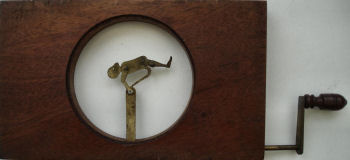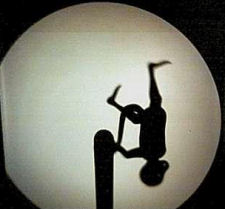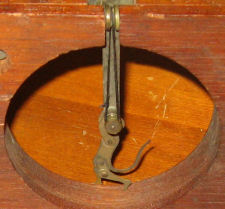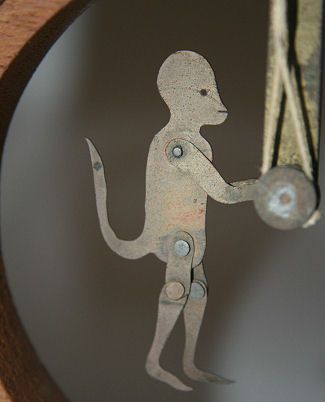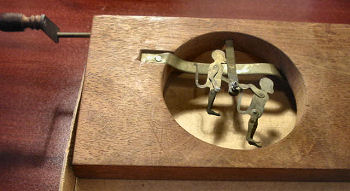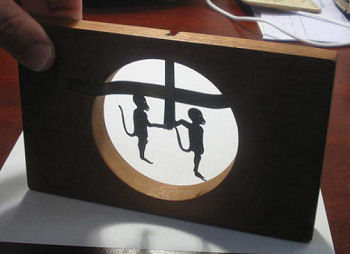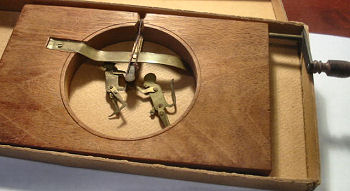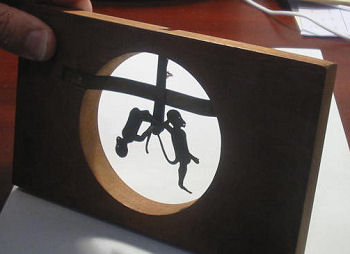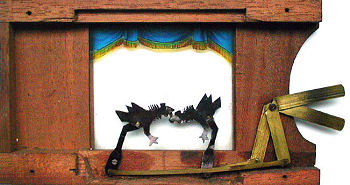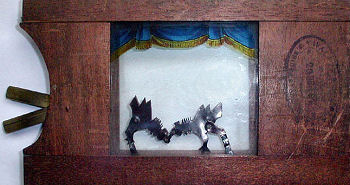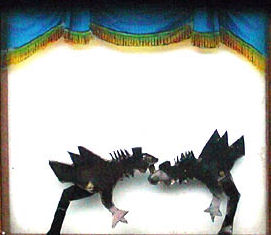|
|
 |
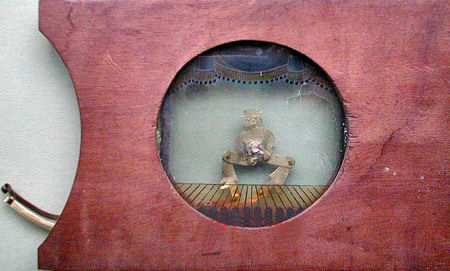 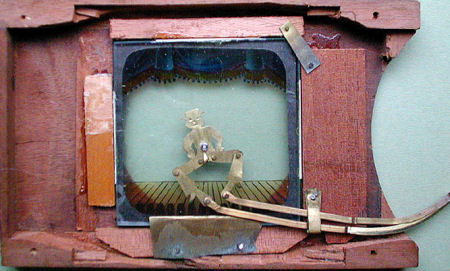 The dancer Photos: ©Pierre Patau, antiquetoysandgames.com. On the third picture the cover is removed so that you can see the mechanism. |
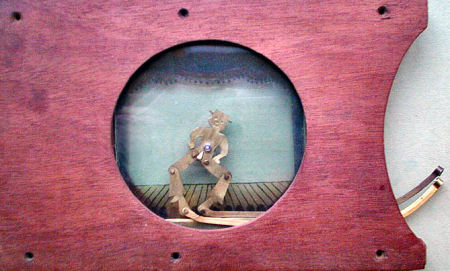 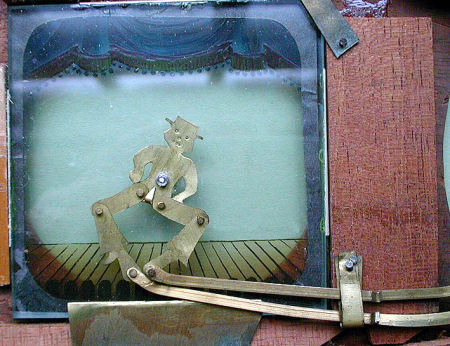 |
 |
|
|
A very rare English fantoccini slide from the 3rd
quarter of the 19th century. It consists of a deep wooden frame with hand painted music hall stage on one side and an animated brass dancing man sandwiched between two glass panels. The body of the dancer is fixed to the glass by its middle and the articulated legs are linked to 2 separate brass "pulls" which animate our dancer, a beautiful effect as the figure is projected as a silhouette onto the screen. 18 cm x 11.5 cm or about 7" x 4 1/2". |
|

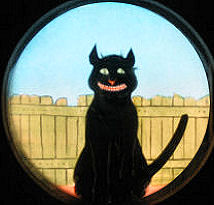
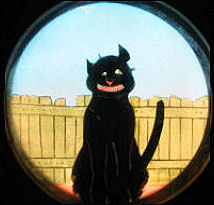
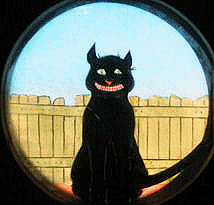 |
|
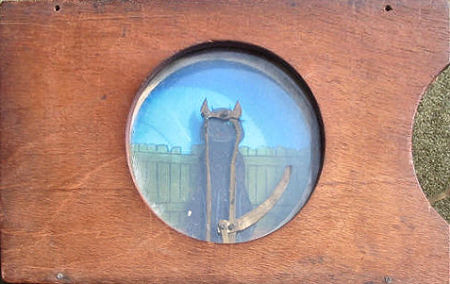 |
Tomcat Rare fantoccini slide showing the silhouette of a tomcat, set against a hand painted background. The slide has two levers which operate a complex action of waggling its ears and tail. The slide measures 7 "x 4.5" (c. 18 x 11.5 cm). |
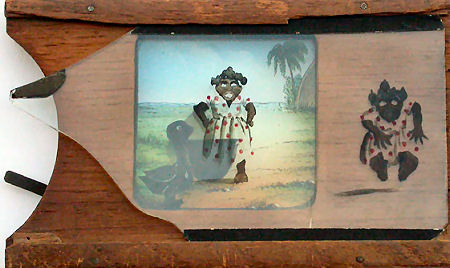 |
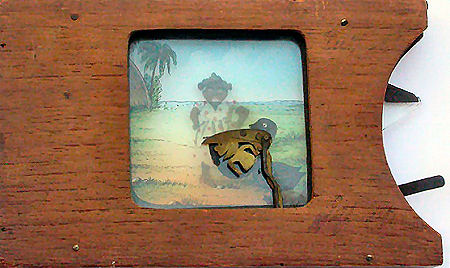
|
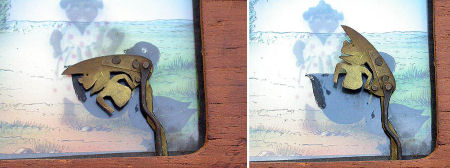
|
The pelican Perfect example of a magic lantern slide combining a slipping mechanism and a brass fantoccini mechanism, operated by means of a lever. A native African woman is unsuspecting watching a pelican and jumps back in terror when it suddenly opens its bill to let a baby out. The background and figure on the slipping glass are hand painted; the baby and upper part of the bill are cut out of thin brass and are operated by a lever. Wonderful! 17.7 cm x 11 cm or 7" x 4 1/4"; 2 cm or 3/4" thick. |
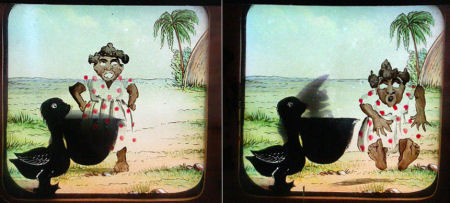
Photos: ©Pierre Patau, antiquetoysandgames.com. | |
 |
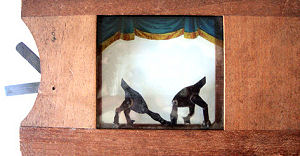 |
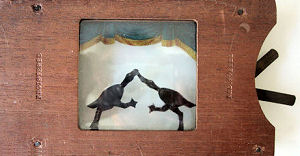 |
|||
|
Two Geese Two metal levers operate the two geese independently while they fight over a morsel of food held by both their beaks. There is a glass screen at each side of the metal hinged image. One of the glasses has a painted curtain. Man and Donkey The next slide is obvious made by the same manufacturer: same design, same theatre curtain, same word 'REGISTRED' impressed in the wood of the frame. |
|||||
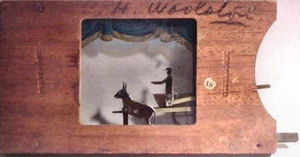 Mechanical silhouette slide depicting a farmer riding a cart that is drawn along by a mule. By means of two brass handles one can move the man and the mule separately. The frame measures 7 inches long by 4 inches tall by about 5/8 of an inch thick (c. 18 x 10 x 1.6 cm). |
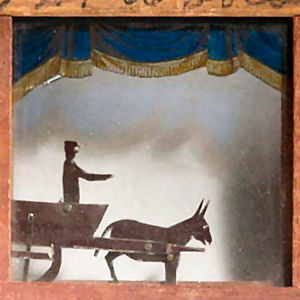 |
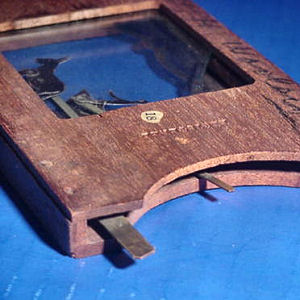 |
|||
|
Will your food cost you more? And then another fantoccini slide with the same blue theatre curtains! The dimensions of the wooden frame are 17.5 x 10 cm (7" x 4"). Under the curtain there is a text, the exact meaning of which escapes me. Behind the glass are a copper parrot and a young man with a bowl in his hands that are equipped with rods with which they can be animated. The parrot's beak opens and closes as the male moves his head back and lifts the bowl. |
||
 |
 |
|
 |
 |
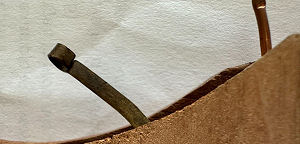 |
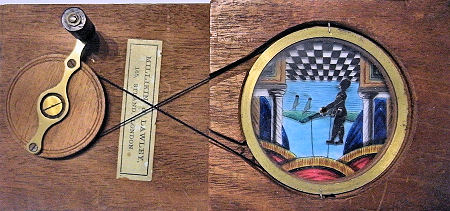 A mechanical magic lantern slide showing an acrobat turning somersaults at the horizontal bar. The acrobat is joined and made of black paper. His hands are glued to the spindle and he is operated by a brass handle that is linked to the moving glass by a thread. At the background a painted stage. A paper label at the mahogany frame says: MILLIKIN & LAWLEY, 165, STRAND, LONDON. |
The Acrobat |
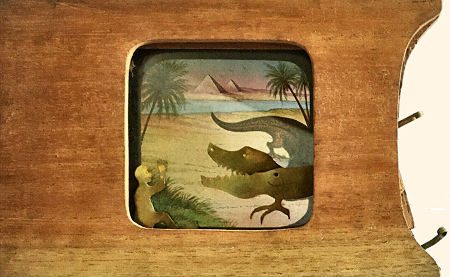 Man and crocodile. |
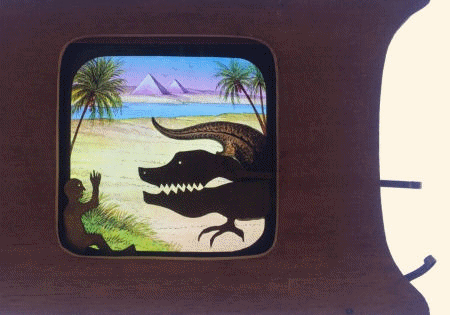 |
|
The head of the crocodile is made of thin
brass. The jaws open and close when the
lever is moved. Opposite him sits a man who is also made of thin messing and
moves back and forth when the other lever is moved. The dimensions are
approximately 18 x 11.4 cm. |
|
| Julia is zo schoon - My Julia is a belle | |
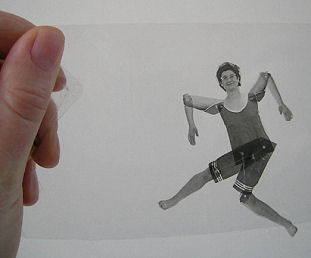 |
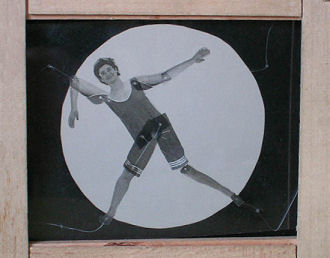 |
|
Finally a modern example of a fantoccini slide. In the period from 1997-2000
some Dutch visual artists produced new, present-day works to be used in magic
lantern shows. The project was called Diascoop. Visual artist Ida Lohman (Utrecht, 6 juli 1962 - Amsterdam, 25 september 2007) created this lively puppet. She copied a photograph to a transparency, the limbs were joined to the trunk and provided with a thin thread. Pulling the strings makes Julia dance. The puppet is c. 7 cm tall; the frame measures 11,5 cm. This work is titled: 'Julia is zo schoon' (My Julia is a belle) after a well-known Dutch camper song. For the projection of Julia two magic lanterns were used to obtain a fast change-over. The humorous song was sung by the operators at the top of their voices. Julia became more and more ugly with every couplet but had again and again a cheerful dance during the refrain. The end of the story is rather sad: the girl is exposed in a museum after her death. |
This is my
attempt to translate the song in English:
My Julia is a belle, she's looking like a fairy Her head is like a bulb; her legs are crooked and hairy Julia, Julia, Ju-li-a Julia, Julia, Ju-li-a Julia, Julia, Ju-li-a, my Julia is just fine. My Julia is a belle, she has a well-groomed hair-style The front is withered grass, the rest bald as a roof tile (Refrain) My Julia is a belle, her lips are sweet as fudges They taste of curly kale, covered with dark brown smudges (Refrain) My Julia is a belle, her eyes are sparkling fire-flies One is of opal glass, they both are gazing crosswise (Refrein) My Julia is a belle, her breasts are soft and mellow The left one is dark blue, the other lemon-yellow (and so the song continues, until the last couplet:) |
|
Now Julia is
dead, laid out in a museum of curiosities; stuffed with straw and petroleum Julia, Julia, Ju-li-a Julia, Julia, Ju-li-a Julia, Julia, Ju-li-a, my Julia is just fine. |
|
| |
©1997-2024 'de Luikerwaal' All rights reserved. Last update: 03-04-2024. |
